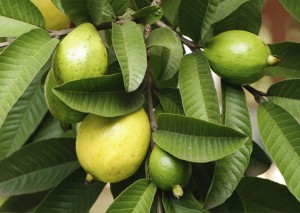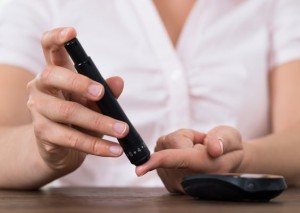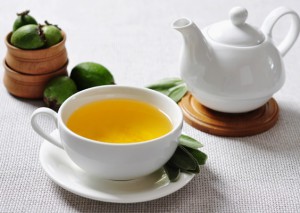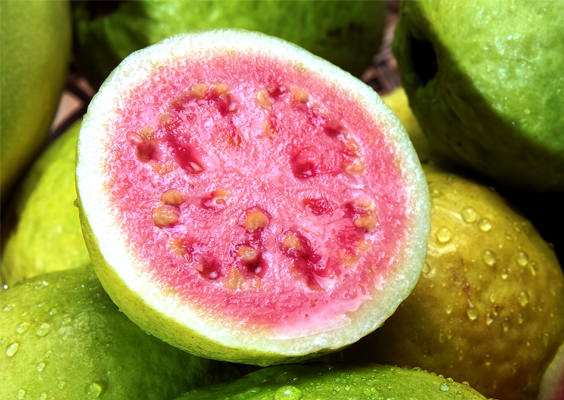
Mainstream medicine wants you to believe the only thing you can do about diabetes is take Big Pharma’s pills or insulin shots for the rest of your life.
Even if you’re not diabetic, all those carbs in your diet — cereal, pasta, potatoes, bread and sugary drinks — means your body is getting a dangerous overload of sugar. And it may be just a matter of time, before you become a statistic in America’s fastest growing health epidemic.
For decades, I’ve been helping my patients not just manage their diabetes symptoms, also to reverse it for good.
And I’ve also been helping them to prevent diabetes in the first place by using natural healing herbs that manage the massive carbohydrate and sugar bombardment we face today.
One of the most effective herbs I’ve found in the battle against diabetes is guava. In fact, guava is such an important healing plant, I’ve included it in my new book — Healing Herbs of Paradise — which will be available next month.

When you think about guava, you probably think of it as the jelly inside tasty pastry treats. But it’s certainly not something your doctor is likely to prescribe for any ailment.
I’ve been recommending guava for years as a rich source of dietary fiber, vitamins A and C, folic acid, potassium, copper and manganese. It’s also a potent antioxidant. These alone are enough of a benefit, because they power up your immune system.
But while speaking with traditional healers on the beautiful Indonesian island of Bali, I learned there’s a lot more to guava.
Ironically, guava is not native to Bali — or anywhere else in Asia for that matter. It’s native to the tropics of the Western Hemisphere. But traders and missionaries brought it to Southeast Asia, where local healers
quickly recognized its medicinal value.In Bali, guava is used regularly to relieve:
- Indigestion;
- Stomach ache and diarrhea;1,2,3,4
- Gastroenteritis;
- Mouth ulcers;
- Gum disease;
- Skin rashes;
- Fungal infections;
- Viruses – It even works against the H1N1 “bird flu” virus strain.5
- Chronic inflammation.
Scientists have also studied 60 compounds from guava for their possible anti-cancer effects. And studies also show that guava has anti-cancer properties. Its extracts have been shown to suppress tumor growth and kill cancer cells in the prostate, breast and colon.6,7,8,9

But guava is especially effective at controlling blood sugar and diabetes — when you eat them without skins.
The stems, leaves and fruit block the digestion of carbohydrates. So you have fewer sugar spikes and need less insulin, which makes you less likely to develop insulin resistance.10,11,12,13
And if you have diabetes, guava will also strengthen your heart and kidneys to resist damage from the disease.14,15
In the U.S., guava season runs from September through December. You can find it by just wandering through your local green market or farmer’s market.
But it’s always guava season somewhere in the world. So you can order this fruit over the Internet on sites like amazon.com, massspectrumbotanicals.com, specialtyproduce.com, localharvest.org, and farmersmarketonline.com.
You may have to search a bit for the leaves. Occasionally, you’ll see the fresh leaves at a health food store, but you’re more likely to find the dried leaves. That’s okay, because they make more potent teas, infusions and decoctions anyway.

Fresh leaves contain more water, so you need to use almost twice as many. And the most potent leaves, those with the most antioxidant power, are harvested just before the fruit is ripe.16
Here’s a recipe I was taught in Bali for a guava leaf decoction, which traditional healers use to treat a number of ailments, including diabetes.
- You need water and guava leaves in a ratio of 8 oz of water to either 1 oz of dried leaves or 2 oz of fresh leaves.
- Place the water into a pot made from non-reactive material, such as enamel or stainless steel. Do not use aluminum.
- Crush the leaves and add them to the water. Soak them for 30 minutes.
- Bring the water to a boil. Then reduce the heat, and simmer with the lid off for 30 to 60 minutes or until one-quarter of the water has evaporated.
- Cool and strain the liquid. Then use a spoon to press the leaves against the strainer so you can squeeze out the last liquid. You can store the decoction in the refrigerator for up to 72 hours. But it’s best to make what you need every day.
To Your Good Health,

Al Sears, MD, CNS
1Lu W, et al. “Screening of anti-diarrhea effective fractions from guava leaf.” Zhong Yao Cai. 2010;33(5):732-5.
2Birdi T, et al. Newer insights into the mechanism of action of Psidium guajava L. leaves in infectious diarrhoea. BMC Complement Altern Med. 2010; 28;10:33
3Ojewole J, et al. Antidiarrhoeal activity of Psidium guajava Linn. (Myrtaceae) leaf aqueous extract in rodents. J Smooth Muscle Res. 2008;44(6):195-207.
4Thuaytong W, et al. Bioactive compounds and prebiotic activity in Thailand-grown red and white guava fruit (Psidium guajava L.). Food Sci Technol Int. 2011;17(3):205-12.
5Sriwilaijaroen N, et al. Antiviral effects of Psidium guajava Linn. (guava) tea on the growth of clinical isolated H1N1 viruses: its role in viral hemagglutination and neuraminidase inhibition. Antiviral Res. 2012;94(2):139-46.
6Ryu N, et. al. “A hexane fraction of guava Leaves (Psidium guajava L.) induces anticancer activity by suppressing AKT/mammalian target of rapamycin/ribosomal p70 S6 kinase in human prostate cancer cells.” J Med Food. 2012;15(3):231-41.
7Gupta S, Phromnoi K, Aggarwal B. “Morin inhibits STAT3 tyrosine 705 phosphorylation in tumor cells through activation of protein tyrosine phosphatase SHP1.” Biochem Pharmacol. 2013;85(7):898-912.
8Karthik Kumar V, Vennila S, Nalini N. “Inhibitory effect of morin on DMH-induced biochemical changes and aberrant crypt foci formation in experimental colon carcinogenesis.” Environ Toxicol Pharmacol. 2010;29(1):50-7.
9Nandhakumar R, Salini K, Niranjali Devaraj S. “Morin augments anticarcinogenic and antiproliferative efficacy against 7,12-dimethylbenz(a)-anthracene induced experimental mammary carcinogenesis.” Mol Cell Biochem. 2012;364(1-2):79-92.
10Rai PK. et al. Anti-hyperglycaemic potential of Psidium guajava raw fruit peel. Indian J Med Res. 2009;129:561-5.
11Huang CS. et al. Antihyperglycemic and antioxidative potential of Psidium guajava fruit in streptozotocin-induced diabetic rats. Food Chem Toxicol. 2011;49(9):2189-95.
12Guo X, et al. Guava leaf extracts promote glucose metabolism in SHRSP.Z-Leprfa/Izm rats by improving insulin resistance in skeletal muscle. BMC Complement Altern Med. 2013;13:52.
13Eidenberger T, et al. Inhibition of dipeptidyl peptidase activity by flavonol glycosides of guava (Psidium guajava L.): A key to the beneficial effects of guava in type II diabetes mellitus. Fitoterapia. 2013;89:74-9.
14Lin CY, et al. Renal protective effects of extracts from guava fruit (Psidium guajava L.) in diabetic mice. Plant Foods Hum Nutr. 2012;67(3):303-8.
15Soman S. et al. Beneficial effects of Psidium guajava leaf extract on diabetic myocardium. Exp Toxicol Pathol. 2013;65(1-2):91-5.
16Adesida A, et al. Free radical scavenging activities of guava extract in vitro. Afr J Med Med Sci. 2012;41 Suppl:81-90.

